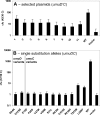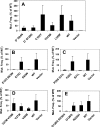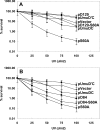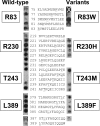Characterization of novel alleles of the Escherichia coli umuDC genes identifies additional interaction sites of UmuC with the beta clamp
- PMID: 19633075
- PMCID: PMC2747890
- DOI: 10.1128/JB.00292-09
Characterization of novel alleles of the Escherichia coli umuDC genes identifies additional interaction sites of UmuC with the beta clamp
Abstract
Translesion synthesis is a DNA damage tolerance mechanism by which damaged DNA in a cell can be replicated by specialized DNA polymerases without being repaired. The Escherichia coli umuDC gene products, UmuC and the cleaved form of UmuD, UmuD', comprise a specialized, potentially mutagenic translesion DNA polymerase, polymerase V (UmuD'(2)C). The full-length UmuD protein, together with UmuC, plays a role in a primitive DNA damage checkpoint by decreasing the rate of DNA synthesis. It has been proposed that the checkpoint is manifested as a cold-sensitive phenotype that is observed when the umuDC gene products are overexpressed. Elevated levels of the beta processivity clamp along with elevated levels of the umuDC gene products, UmuD'C, exacerbate the cold-sensitive phenotype. We used this observation as the basis for genetic selection to identify two alleles of umuD' and seven alleles of umuC that do not exacerbate the cold-sensitive phenotype when they are present in cells with elevated levels of the beta clamp. The variants were characterized to determine their abilities to confer the umuD'C-specific phenotype UV-induced mutagenesis. The umuD variants were assayed to determine their proficiencies in UmuD cleavage, and one variant (G129S) rendered UmuD noncleaveable. We found at least two UmuC residues, T243 and L389, that may further define the beta binding region on UmuC. We also identified UmuC S31, which is predicted to bind to the template nucleotide, as a residue that is important for UV-induced mutagenesis.
Figures






Similar articles
-
Characterization of Escherichia coli UmuC active-site loops identifies variants that confer UV hypersensitivity.J Bacteriol. 2011 Oct;193(19):5400-11. doi: 10.1128/JB.05301-11. Epub 2011 Jul 22. J Bacteriol. 2011. PMID: 21784925 Free PMC article.
-
Genetic interactions between the Escherichia coli umuDC gene products and the beta processivity clamp of the replicative DNA polymerase.J Bacteriol. 2001 May;183(9):2897-909. doi: 10.1128/JB.183.9.2897-2909.2001. J Bacteriol. 2001. PMID: 11292811 Free PMC article.
-
umuDC-mediated cold sensitivity is a manifestation of functions of the UmuD(2)C complex involved in a DNA damage checkpoint control.J Bacteriol. 2001 Feb;183(4):1215-24. doi: 10.1128/JB.183.4.1215-1224.2001. J Bacteriol. 2001. PMID: 11157933 Free PMC article.
-
Y-family DNA polymerases in Escherichia coli.Trends Microbiol. 2007 Feb;15(2):70-7. doi: 10.1016/j.tim.2006.12.004. Epub 2007 Jan 4. Trends Microbiol. 2007. PMID: 17207624 Review.
-
Genetic analyses of cellular functions required for UV mutagenesis in Escherichia coli.Basic Life Sci. 1990;52:269-75. doi: 10.1007/978-1-4615-9561-8_22. Basic Life Sci. 1990. PMID: 2183772 Review.
Cited by
-
The Roles of UmuD in Regulating Mutagenesis.J Nucleic Acids. 2010 Sep 30;2010:947680. doi: 10.4061/2010/947680. J Nucleic Acids. 2010. PMID: 20936072 Free PMC article.
-
Altering the N-terminal arms of the polymerase manager protein UmuD modulates protein interactions.PLoS One. 2017 Mar 8;12(3):e0173388. doi: 10.1371/journal.pone.0173388. eCollection 2017. PLoS One. 2017. PMID: 28273172 Free PMC article.
-
A dnaN plasmid shuffle strain for rapid in vivo analysis of mutant Escherichia coli β clamps provides insight into the role of clamp in umuDC-mediated cold sensitivity.PLoS One. 2014 Jun 4;9(6):e98791. doi: 10.1371/journal.pone.0098791. eCollection 2014. PLoS One. 2014. PMID: 24896652 Free PMC article.
-
Characterization of Escherichia coli UmuC active-site loops identifies variants that confer UV hypersensitivity.J Bacteriol. 2011 Oct;193(19):5400-11. doi: 10.1128/JB.05301-11. Epub 2011 Jul 22. J Bacteriol. 2011. PMID: 21784925 Free PMC article.
-
The dimeric SOS mutagenesis protein UmuD is active as a monomer.J Biol Chem. 2011 Feb 4;286(5):3607-17. doi: 10.1074/jbc.M110.167254. Epub 2010 Nov 29. J Biol Chem. 2011. PMID: 21118802 Free PMC article.
References
-
- Becherel, O. J., R. P. P. Fuchs, and J. Wagner. 2002. Pivotal role of the β-clamp in translesion DNA synthesis and mutagenesis in E. coli cells. DNA Repair 1:703-708. - PubMed
-
- Beuning, P. J., D. Sawicka, D. Barsky, and G. C. Walker. 2006. Two processivity clamp interactions differentially alter the dual activities of UmuC. Mol. Microbiol. 59:460-474. - PubMed
-
- Beuning, P. J., S. M. Simon, V. G. Godoy, D. F. Jarosz, and G. C. Walker. 2006. Characterization of Escherichia coli translesion synthesis polymerases and their accessory factors. Methods Enzymol. 408:318-340. - PubMed
-
- Beuning, P. J., S. M. Simon, A. Zemla, D. Barsky, and G. C. Walker. 2006. A non-cleavable UmuD variant that acts as a UmuD′ mimic. J. Biol. Chem. 281:9633-9640. - PubMed
Publication types
MeSH terms
Substances
Grants and funding
LinkOut - more resources
Full Text Sources
Molecular Biology Databases

